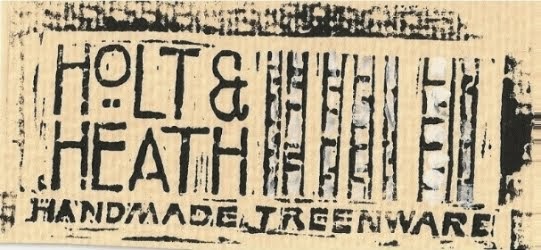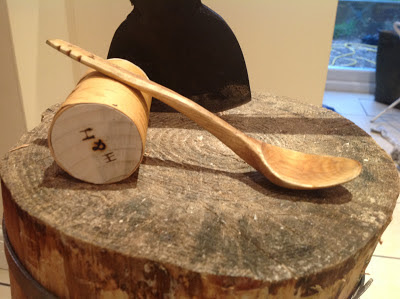I feel a little self-conscious when I put up yet another post about yet more spoons as, to your average Joe, once you've seen one hand carved wooden spoon, to be quite honest, you've already seen one too many. I reasure myself, however, that for people of a like mind to me, you just can't get enough. It doesn't matter how many Robin or Sean or Steve or Alastair spoons I've previously seen, I still love looking at new ones. I'm hoping that the same applies here.
I've noticed when looking at others' blogs that, much like me, those who attended Spoonfest were particularly taken by Jarrod Stonedhal - both the man himself who, to put it simply, anyone would be thrilled to have as a neighbour, and his beautifully delicate and carefully rustic spoons. It's no coincidence that since Jarrods's spoons became more public, there's been a proliforation of painted spoons and tableware, not that he has a monopoly on paint, but he does it very well - I've yet to see any that hold a light to his.
The truth is, his were the only spoons I really wanted to buy a sample of from Spoonfest and, ironically, the first to sell out, hence I didn't get one and I mourned the fact for a couple of weeks after. Julian did get one, however, which I was very glad to have a go at copying.
 |
| Julian's Jarrod spoon - just perfect |
 |
| As pointed out by Sean Hellman - cranked profile |
My first attempts were in ash, and I was fairly pleased with the results.

Then I did one out of some very green rhododendron. I'd not used this wood before and it was a pleasure to carve - not unlike peeling potatoes, though because of the wood's softness, it didn't chip carve cleanly - probably should have let it dry out first.
Liking the design, yesterday I had a go with some curly grained ash, but this time a larger serving spoon.

I must apologise for the poor quality of the photos - it's just ipad quality as the lense on my Olympus PEN is broken and I can't bring myself to spend the money it will cost to repair or replace it.
Whilst I'm apologising, I should say something about the odd and fairly random layout of my posts - I HATE BLOGGER! It is the most unpredicatable software I think I have ever used. It is often impossible to do the simplest things. Come on Blogger developers, do something about it!




















